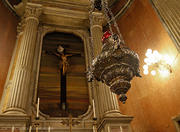Igreja da Candelária Picture 8

More information on Igreja da Candelária in Rio de Janeiro Photo by: Lorando Labbe
Igreja da Candelária in Rio de Janeiro
The church of Our Lady of Candelaria is located in the city center of Rio de Janeiro. It is one of the main religious monuments in the city.
The parochial chapel of Candelaria in 1710 but was reformed in the second half of the eighteenth century, needed to expand. Sergeant-Major John Francis Roscio, Portuguese military engineer, designed the plans for a new church. Construction began in 1775 and the inauguration, with the still unfinished church, occurred in 1811 in the presence of the Prince Regent and future King of Portugal, D. John VI. The church had at that time, a single nave and altar inside the church had been sculpted by Mestre Valentim, the great artist of the rococo style of Rio, but were replaced in later reforms.
The facade and the general design of a Latin cross plan with a dome over the transept resemble some of the Portuguese Baroque works, such as the church of the Mafra Convent (1717-1730), near Lisbon and the Basilica da Estrela (1779-1790) in the Portuguese capital. The facade is particularly beautiful from the Brazilian colonial churches. As well as most of the colonial churches of Rio, the facade of the Candelaria church is facing the Bay of Guanabara, since that was the primary route of entry into the city.
Some time after the inauguration of the church, the project was expanded to three ships. The ship was constructed previously replaced, but was kept the original façade of the project Roscio. In 1856 ended the doming of the naves and chapels, missing the dome of the transept, which was a major engineering problem at the time.
After the intervention of several architects, including Justin Alcantara, Francisco Joaquim Béthencourt da Silva, Daniel Ferro Pedro Cardoso and German Carl Friedrich Gustav Waehneldt, the dome was finally completed in 1877. The various parts of the dome in stone lioz Portuguese, were made in Lisbon, as well as the eight statues that adorn the sculpted by Portuguese Jose Cesario de Salles. When completed, the dome of Candelaria was the tallest building in town.
[Edit] Interior decoration
From 1878, he began decorating the interior of the church, following a model neorrenascentista Italian marble-clad Italian polychrome walls and columns, thus moving away from current models in the colonial era. The interior was designed by Antonio de Paula Freitas and Heitor Cordoville.
View from the roof of the dome with paintings of the Candelaria Zeferino da Costa and his staff
The magnificent wall paintings inside the Church were entrusted to the Brazilian João Zeferino da Costa, painter and professor at the Imperial Academy of Fine Arts, and these are considered his masterpieces. Zeferino had the help of a yard of good painters like Henry Bernardelli, Oscar Pereira da Silva and the Italian Giambattista Castagneto, among others. The paintings are distributed through the roof of the aisles, dome and chapel and were conducted between 1880 and late nineteenth century.
On the roof of the nave, there are six panels that tell the early history of the Candelaria church, since the founding of the trip until the first consecration, while at the summit, the paintings represent the Virgin, the virtues and Old Testament figures (Jesse, Isaiah, David and Solomon).
Other important details of the interior are the main altar of the Brazilian Archimedes Memory, the Germans and the huge stained glass pulpits in art nouveau style of the Portuguese sculptor Rodolfo Pinto do Couto (1931). In 1901, we installed the beautiful bronze doors at the entrance of the church, the work of Portuguese Teixeira Lopes.
The church of Candelaria is one of the major artworks of the nineteenth century Brazil, the quality of the names involved, the neoclassical architecture and lush interior decoration, in neoclassical style and eclectic mix. To this is added the beautiful facade, a masterpiece of the eighteenth century, which shows a big contrast between harmony in the parts painted white and dark granite carioca, besides the different window profiles, the two towers and pediment classic.
http://pt.wikipedia.org/wiki/Igreja_de_Nossa_Senhora_da_Candel%C3%A1ria
More Photos of Igreja da Candelária Picture 8
















